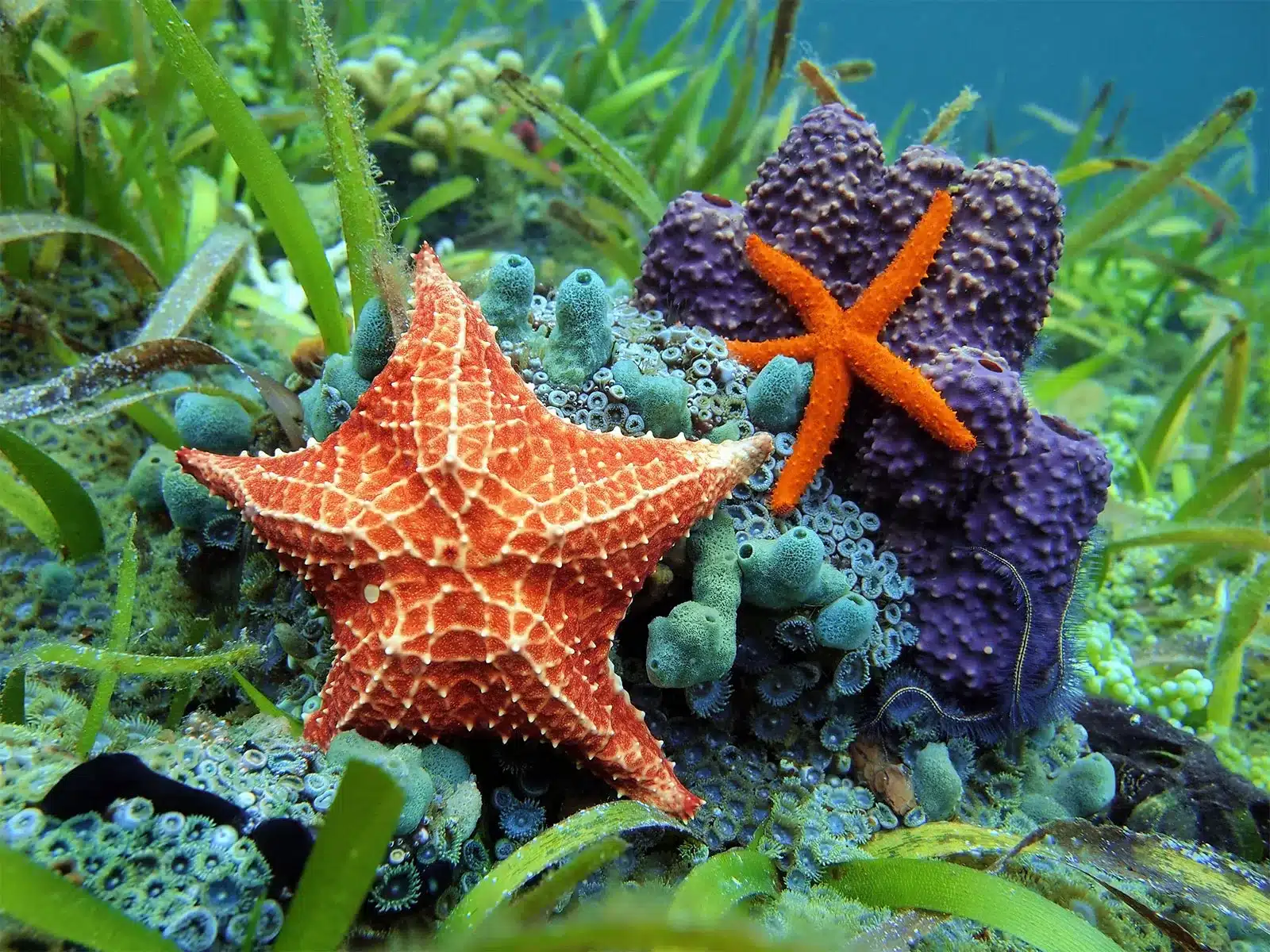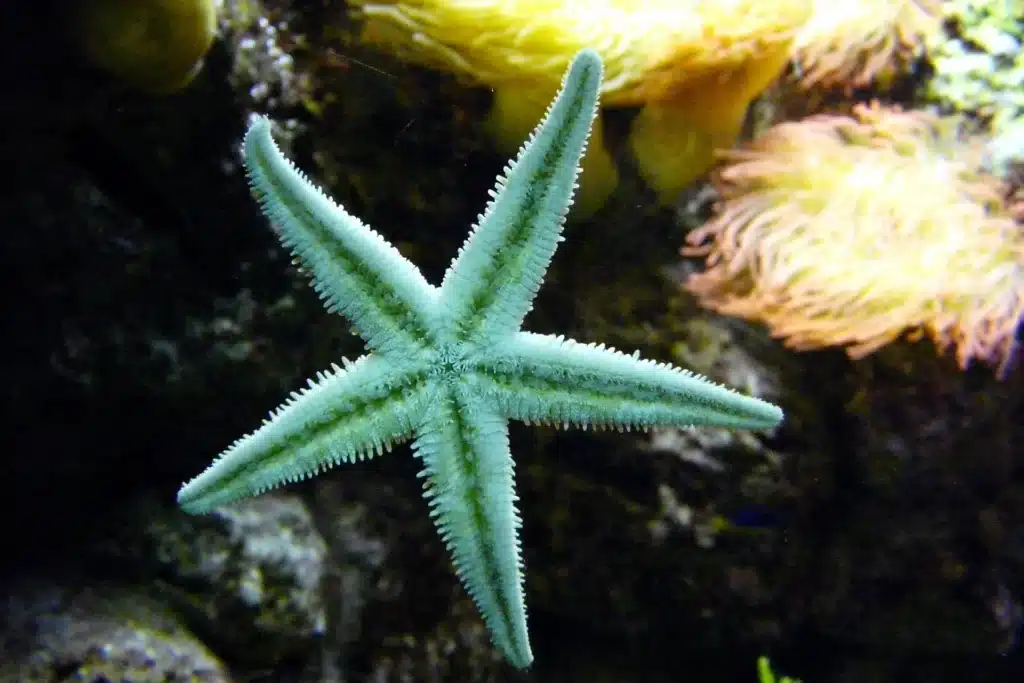What Is The Habitat For Starfish

Introduction
What Is The Habitat For Starfish: Starfish live, also known as sea stars, are fascinating marine creatures found in oceans across the globe. These remarkable animals are renowned for their unique appearance and intriguing behaviors. One of the fundamental aspects of understanding starfish biology is their habitat, which plays a crucial role in shaping their lives.
The habitat for starfish is primarily the vast expanse of the world’s oceans, where they occupy a wide range of environments, from shallow coastal waters to the abyssal depths. Their distribution spans from the polar regions to the tropics, demonstrating their adaptability to diverse conditions.
In coastal regions, you can often spot starfish in the intertidal zones, where the ocean meets the land. These areas are rich in biodiversity, offering an array of food sources for starfish, including mollusks, crustaceans, and algae. Their presence in these zones is essential for maintaining the balance of marine ecosystems.
Starfish are also found on the ocean floor, with some species inhabiting rocky seabeds and others preferring sandy or muddy bottoms. Their unique tube feet and radial symmetry enable them to navigate various substrates effectively. They are opportunistic predators, using their tube feet to capture prey and their powerful stomachs to digest it externally.
Starfish have evolved to survive in extreme conditions. Some species are adapted to cold waters, while others thrive in warm, tropical seas. Understanding their habitat is crucial not only for appreciating their ecological significance but also for preserving these mesmerizing creatures for future generations to admire and study.

Do starfish live on land or water?
Sea stars, commonly called, “starfish,” are not fish.
There are approximately 2,000 species of sea star, all of which live in marine waters. Sea stars live underwater, but that is where their resemblance to fish ends. They do not have gills, scales, or fins. Sea stars live only in saltwater.
Starfish, also known as sea stars, are exclusively aquatic creatures, which means they live in water and do not inhabit land. They are marine animals belonging to the phylum Echinodermata and the class Asteroidea. Starfish are found in various marine environments, including oceans, seas, and coastal areas worldwide. These fascinating creatures have adapted to life in the sea over millions of years, and their biology is intricately tied to aquatic environments.
Starfish have a unique body structure with tube feet and a water vascular system that they use for locomotion, respiration, and capturing prey. Their skin is covered in tiny, calcareous plates known as ossicles, which provide protection and support in the buoyant water.
While starfish are superbly adapted to aquatic life, they cannot survive on land for extended periods. If removed from the water, their tube feet lose their functionality, and they become immobile. Without water, starfish quickly dehydrate, and their vital physiological processes are disrupted, ultimately leading to their demise.
These marine environments offer a diverse range of ecosystems, from rocky shores to sandy seabeds, where various species of starfish have found their niche and play important roles in the intricate web of marine life
Where do starfish feed?
They usually feed on coral, sponges, clams, oysters, sand dollars, and mussels because these animals also attach themselves to rocks and move slowly, so they’re nearby. Some starfish will also eat other animals, such as fish, if they are injured and unable to move away in time.
Starfish, also known as sea stars, are carnivorous marine creatures that primarily feed on a variety of prey found in their underwater habitats. The specific feeding habits and diet of starfish can vary depending on their species, but they generally feed in the following ways:
- Predation on Bivalves and Mollusks: Many starfish are known for their ability to pry open the shells of bivalves such as clams and mussels. They use their tube feet to grip and exert force on the shells, eventually creating a gap through which they can insert their stomach.
- Hunting for Crustaceans: Some starfish, particularly larger species, hunt crustaceans such as crabs and shrimp. They use their tube feet and extendable stomachs to envelop and digest their prey.
- Scavenging: In addition to actively hunting, starfish are opportunistic scavengers. They may feed on dead or decaying marine animals they encounter on the ocean floor.
- Filter Feeding: Certain smaller starfish species are filter feeders. They use their tube feet to create water currents that draw in plankton and tiny organic particles, which they then capture and consume.
What is the habitat of starfish?
Habitat: Sea star habitats are highly variable; these animals can be found in all ocean basins of the world and at a large assortment of depths and bottom composition. They are benthic animals, which means that they live on the ocean floor whether they are in deep or shallow water.
The habitat of starfish, also known as sea stars, encompasses a diverse range of marine environments, as they are exclusively aquatic creatures. These fascinating marine animals can be found in oceans, seas, and coastal areas worldwide. Here’s an overview of their habitat:
- Intertidal Zones: Starfish are often found in intertidal zones, which are areas along the coastline where the ocean meets the land. These zones include rocky shorelines, tide pools, and sandy or muddy seabeds. Starfish thrive in intertidal habitats, where they have access to a rich variety of prey and can withstand exposure to air during low tide.
- Rocky Reefs: Many species of starfish are well adapted to rocky reef habitats, where they cling to rocks and crevices. Their tough, flexible bodies and tube feet allow them to navigate and feed on small invertebrates in these areas.
- Sandy and Muddy Bottoms: Some starfish species prefer habitats with sandy or muddy substrates on the ocean floor. They burrow into the sediment or move along the seabed in search of prey like clams, mollusks, and detritus.
- Tropical Coral Reefs: In tropical regions, certain starfish species inhabit coral reefs, where they interact with the diverse coral reef ecosystem. They can serve as both predators and scavengers in these environments.
- Deep-Sea Environments: Starfish also inhabit deep-sea environments, including the abyssal plains, where they have adapted to survive in extreme conditions, such as low temperatures and high pressure.
How do starfish live for?
2. They can live up to 35 years. 3. Starfish is not their right name, they should always be called Sea Star!
The lifespan of a starfish can vary depending on several factors, including its species, environmental conditions, and predation risks. On average, starfish tend to live for several years, with some species having longer lifespans than others. Here are some key points about the lifespan of starfish:
- Species Variation: Different species of starfish have different lifespans. Some smaller species may only live for a few years, while larger and more robust species can have lifespans ranging from 5 to 35 years or more.
- Environmental Factors: Environmental conditions, such as water temperature, food availability, and habitat quality, can significantly impact the lifespan of a starfish. Warmer waters, for instance, can accelerate their metabolic rates, potentially shortening their lifespan.
- Predation: Predation is a significant factor affecting the lifespan of starfish. They are vulnerable to various predators, including sea otters, birds, and certain fish species.
- Reproduction: The reproductive strategy of a starfish can also influence its lifespan.
- Regeneration: Starfish are well-known for their ability to regenerate lost body parts. This regenerative capacity can help them recover from injuries and potentially extend their lifespan.
The lifespan of a starfish can vary widely depending on species and environmental factors. On average, many starfish species live for several years, but their ability to avoid predation, adapt to changing conditions, and reproduce can all impact their individual lifespans.
What do starfish need to survive?
Sea stars live only in saltwater. Sea water, instead of blood, is actually used to pump nutrients through their bodies via a ‘water vascular system. ‘ Also, sea stars move by using tiny tube feet located on the underside of their bodies.
Starfish, also known as sea stars, have specific requirements for survival, which are closely tied to their aquatic habitat and unique biological characteristics. Here are the key factors that starfish need to survive:
- Adequate Water: Starfish are exclusively aquatic animals and rely on a marine environment to survive. Water is essential for their respiration, as they breathe through tiny tube feet and dermal gills.
- Food Sources: Starfish are carnivorous predators that feed on a variety of marine organisms, such as mollusks, crustaceans, and small fish.
- Saltwater Salinity: Starfish are marine animals and require a specific salinity level in the water to maintain their osmotic balance.
- Suitable Habitat: Starfish occupy various marine habitats, including intertidal zones, rocky reefs, sandy or muddy seabeds, and coral reefs.
- Temperature: Different species of starfish have varying temperature preferences, but they generally need water within a suitable temperature range for their metabolic processes.
- Protection from Predators: Starfish have various predators, including sea otters, birds, and certain fish. They use camouflage and defensive strategies, such as regenerating lost body parts, to protect themselves from predation.
Starfish need access to a suitable marine habitat with appropriate water conditions, a steady supply of food, and protection from predators to survive. Their ability to adapt to various ecosystems and their unique biological features make them resilient and vital components of marine ecosystems.
How do starfish live without a heart?
Jellyfish, starfish, and even corals manage very well without hearts. Starfish do not even have blood, so this explains why no heart is required. Instead, they use small hair-like structures called cilia to push seawater through their bodies and they extract oxygen from the water.
Starfish are fascinating marine creatures known for their unique biology, which includes the absence of a traditional heart. Instead of a central pumping organ, starfish rely on a complex network of structures and systems to circulate fluids and oxygen throughout their bodies.
Starfish have a simple circulatory system called a water vascular system. It consists of a series of canals and tube feet that work together to transport seawater throughout their body. This system serves multiple functions, including locomotion, respiration, and even capturing prey.
Here’s how it works: Seawater is drawn into the starfish through small structures called sieve plate podia. Once inside, the water moves through the canals and eventually enters specialized tube feet, which extend and retract to facilitate movement and manipulate objects. These tube feet also play a role in gas exchange, allowing oxygen to diffuse from the seawater into the starfish’s tissues and expelling carbon dioxide.
Starfish have a unique ability to tolerate low oxygen levels, which helps them survive in various marine environments. While they lack a heart, their ingenious water vascular system has evolved to compensate for this absence, enabling them to thrive and adapt to their underwater habitats.
Do starfish live in specific regions of the ocean?
Starfish are found in various oceanic regions, from intertidal zones to deep-sea habitats. They adapt to different depths, temperatures, and types of seabeds.
Starfish, also known as sea stars, are found in various regions of the world’s oceans, and they exhibit a wide distribution across different habitats. These remarkable marine creatures are adaptable and can thrive in a range of environmental conditions. Here are some key points regarding their distribution:
- Global Presence: Starfish are not limited to specific regions of the ocean; they are found in oceans worldwide, from tropical to polar waters. They inhabit both shallow coastal areas and deeper ocean depths.
- Habitat Variability: Different species of starfish have adapted to specific habitats within the ocean. Some prefer rocky intertidal zones, while others thrive in sandy or muddy seabeds. Some even live in coral reefs or kelp forests.
- Temperature Range: Starfish exhibit a wide tolerance for temperature variations. They can be found in cold waters, such as those in polar regions, as well as in warmer tropical and subtropical waters.
- Depth Range: Starfish inhabit various depths within the ocean, from the seashore to the abyssal zone, which can be thousands of meters deep.
- Diversity: There are over 2,000 known species of starfish, and their distribution varies depending on the species. Some are more regionally restricted, while others have a broader distribution.
Where can I find starfish in the intertidal zone?
In the intertidal zone, you can discover starfish during low tide. They often cling to rocks, seafloor substrates, or hide in tide pools.
Starfish can be commonly found in the intertidal zone, a dynamic area along coastlines that experiences regular changes in water level due to the tides. These fascinating marine creatures are well-adapted to this unique habitat. You can often spot them clinging to rocks, nestled in tide pools, or slowly moving across the sandy or rocky substrate.
One of the best places to find starfish in the intertidal zone is along rocky shorelines. These areas provide ample hiding spots and crevices where starfish can take refuge during low tide to avoid desiccation and predation. Tide pools, which form when depressions in the rocks trap seawater, are also prime locations for encountering these iconic echinoderms.
These starfish are adept at digging into the sand and can sometimes be found just beneath the surface. Keep in mind that the availability of starfish can vary by location and season, so it’s always a good idea to consult local tide charts and visit during low tide to increase your chances of spotting these mesmerizing creatures in their natural habitat.

Conclusion
The habitat for starfish is a testament to the remarkable adaptability of these marine creatures. From the icy waters of the polar regions to the tropical seas, starfish have found their niche in a wide range of environments within the world’s oceans. Their ability to thrive in diverse habitats speaks to their resilience and ecological importance.
The intertidal zones, where the ocean meets the land, are particularly vital for many starfish species. These areas are hubs of biodiversity, and starfish play a crucial role in maintaining the balance of these ecosystems by preying on various marine organisms.
Their presence on the ocean floor, whether on rocky, sandy, or muddy substrates, highlights their versatility. Their unique anatomy, including tube feet and radial symmetry, enables them to navigate and feed effectively in these different environments.
As we continue to explore and understand the habitats of starfish, we gain deeper insights into their biology and ecological significance. Preserving these habitats is essential not only for the survival of starfish but also for the health of marine ecosystems as a whole.
The habitat of starfish is a testament to the intricate web of life in our oceans. It underscores the need for conservation efforts to protect these vital ecosystems and the fascinating creatures, like starfish, that call them home. Understanding and appreciating their habitats is the first step toward ensuring their continued existence and the preservation of our planet’s biodiversity.



